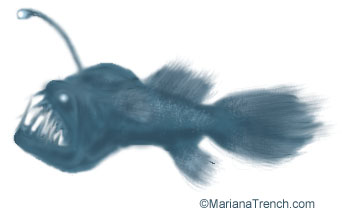Tuhan itu Maha Pencipta Sekalian makhluk...
Kita berada di atas muka bumi ini berkongsi bersama h ...
SulurBidar Post at 25-5-2012 05:52 PM 
MARIANA TRENCH
The deepest part of the ocean is called the abyssal zone. it is host to thousands of species of invertebrates and fish including such oddities as the Angler Fish (see illustration), so called because it uses a bioluminescent (life light) protrusion to attract its prey. The Challenger Deep in the Mariana Trench is very cold, and highly pressurized; its floor features hydrothermal (hot water ) vents formed by spreading tectonic plates which release hydrogen sulfide and other minerals which are consumed by the barophilic bacteria which are then consumed by other microorganisms, which are in turn, consumed by the fish, and so on. The temperature around the vents can reach up to 300° Celsius (572° Fahrenheit). The venting fluid is highly acidic, while the water from the deep ocean is slightly basic. Although the venting fluid is prevented from boiling due to its dissipation into the surrounding freezing water, creatures from the deep show an incredible resistance to temperature extremes by having different proteins which are adapted for life under these conditions; allowing the animals to eat, process food, and reproduce.The highest temperature bacteria can withstand is 113° Celsius (235° Fahrenheit), and the highest any animal can withstand is 50° Celsius (122° Fahrenheit).
One animal which thrives near hydrothermal vents is the Bythograea thermydron, of "Vent Crab" - their numbers are so vast that scientists are using the crab clusters to locate hydrothermal vents. Crabs and Angler Fish are but few of the many species of the Mariana Trench. One mud sample taken from Challenger Deep by Oceanographers from the Kaiko yielded nearly over 200 different microorganisms. Although there seems to be an abundance of life at these depths, no human being could withstand the pressure extremes.
Another interesting characteristic of these deep sea creatures is their longevity; many of these animals having a lifespan of over one hundred years, provided of course that they do not end up in fishing nets. Since these creatures seldom migrate and are slow to develop, there is growing concern over their endangerment.
Most of the planet's oceans are very dark. At a depth of 150 meters (approx. 500 feet), there is little if any light left, and colors are no longer visible to the human eye. As odd as it may seem, we know more about outer space than we do about the deep oceans of our own planet.
The ocean floor at such depth consists of pelagic sediment, also known as[size=-1]biogenous "ooze". Pelagic sediment is composed of shells, animal skeletons, decaying microorganisms and plants; it is generally yellowish and very viscous.

|